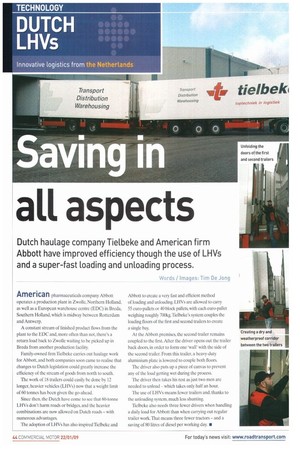all aspects
Page 44

If you've noticed an error in this article please click here to report it so we can fix it.
Dutch haulage company Tielbeke and American firm Abbott have improved efficiency though the use of LHVs and a super-fast Loading and unloading process.
Words / Images: Tirn De Jong American pharmaceuticals company Abbott operates a production plant in Zwolle, Northern Holland, as well as a European warehouse centre (EDC) in Breda, Southern Holland, which is midway between Rotterdam and Antwerp.
A constant stream of finished product flows from the plant to the EDC and, more often than not, there's a return load back to Zwolle waiting to be picked up in Breda from another production facility Family-owned firm Tielbeke carries out haulage work for Abbott, and both companies soon came to realise that changes to Dutch legislation could greatly increase the efficiency of the stream of goods from north to south.
The work of 18 trailers could easily be done by 12 longer, heavier vehicles (LHVs) now that a weight limit of 60 tonnes has been given the go-ahead.
Since then, the Dutch have come to see that 60-tonne LHVs don't harm roads or bridges, and the heavier combinations are now allowed on Dutch roads — with numerous advantages.
The adoption of LHVs has also inspired Tielbeke and Abbott to create a very fast and efficient method of loading and unloading. LITVs are allowed to carry 55 euro-pallets or 40 block pallets, with each euro-pallet weighing roughly 700kg.Tielheke's system couples the loading floors of the first and second trailers to create a single bay.
At the Abbott premises, the second trailer remains coupled to the first. After the driver opens out the trailer back doors. in order to form one 'wallwith the side of the second trailer. From this trailer, a heavy-duty aluminium plate is lowered to couple both floors.
The driver also puts up a piece of canvas to prevent any of the load getting wet during the process.
The driver then takes his rest as just two men are needed to unload — which takes only half an hour.
The use of LHVs means fewer trailers and, thanks to the unloading system, much less shunting.
Tielbeke also needs three fewer drivers when handling a daily load for Abbott than when carrying out regular trailer work.That means three fewer tractors — and a saving of 80 litres of diesel per working day. MI
















































































































































